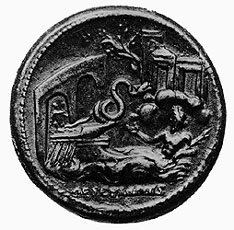Reverse of a bronze medallion of Antoninus Pius (138-161 CE), Rome


Pliny, in his Natural History, says that the first doctor (medicus) to come to Rome was Arcagathus, who arrived from the Greek Peloponnese in 219 BCE and was well received. Arcagathus was accorded the rights of citizenship and a medical shop was set up at state expense for his use. Prior to this time, Rome had no physicians and only home remedies were used. Because Arcagathus was an expert wound surgeon (uulnerarius), he immediately became popular; however his popularity did not last. His vigorous use of the knife and cautery soon earned him the title “Executioner” (Carnifex). From there it was downhill for the medical cause in Rome. Over 100 years lapsed before we hear that another Greek physician (Asclepiades of Bithynia, ca. 100 BCE) had taken up residence in Rome.
Reverse of a bronze medallion of Antoninus Pius (138-161 CE), Rome
Tiber welcomes Asclepius in the form of a snake. In 295 BCE a plague ravaged Rome and the Romans decided to recruit the services of the Greek god of medicine. No doubt the Romans had heard of the success of the medical shrines in the Hellenistic world and hoped some of this power might be transferred to Rome. A temple to Ascelpius was built on the island in the Tiber, not inside Rome, and this was a reflection of the Roman official suspicion of foreign gods. The pestilence soon went away and the popularity of the new cult was assured. The introduction of Asclepius is the first event of “medical history” in Rome. |
Before the arrival of Arcagathus, early Roman medicine was agriculturally based, having its spirit derived from the farm. Early authors of agricultural treatises, such as Cato the Elder and Columella, both from the early second century BCE, had as much to say about medicine, or home remedies, as they had to say about growing seasons, animal husbandry and slave discipline. In Cato’s time, the pater familias, or head of the family, was the dispenser of remedies to his household because his knowledge of the farm and its needs qualified him to deal with matters of health. Characteristic of early Roman medicine was a reliance upon one or two remedies. According to Pliny, the “early Romans gave wool awesome powers”, confirming the religious-agricultural context of early remedies. Unwashed wool, according to the early traditions, dipped into a mixture of pounded rue and fat, was good for bruises and swellings. Rams’ wool, washed in cold water and soaked in oil, was used to soothe uterine inflammations. Wool dipped into a mixture of oil, sulphur, vinegar, pitch and soda cured lumbago. Yet for all its uses, for Cato at least, wool was not the cure-all that cabbage was. Cato advocated not only the consumption of cabbage itself to fend off illness, but the consumption of the urine of a person who has eaten cabbage. |
“If you have reason to fear sickness, give the patient/oxen before they get sick the following remedy: 3 grains of salt, 3 laurel leaves, 3 leek leaves, 3 spikes of leek, 3 of garlic, 3 grains of incense, 3 plants of Sabine herb, 3 leaves of rue, 3 stalks of bryony, 3 white beans, 3 live coals, and 3 pints of wine. You must gather, macerate, and administer all these things while standing, and he who administers the remedy must be fasting. Administer to each ox or to the patient for three days, and divide it in such a way that when you have administered three doses to each, you have used it all. See to it that the patient and the one who administers are both standing, and use a wooden vessel.”
Magical connotation is clear from the continual use of three of each ingredient. The greater part of this remedy consists of foodstuffs from the pantry. Possibly the standing position is a remnant of psychological factors pointing to an earlier time of medicine man or shaman. The insistence upon a wooden bowl shows this recipe to be an ancient one.
The Romans inherited some of their ideas of anatomy and medicine from their Etruscan ancestors and adapted them to the practice of the official state religion, specifically in the practice of hepatoscopy, or reading the divine signals in animal livers. Models of bronze livers which were used by priests to interpret omens within the liver have been unearthed in Etruria. Hepatoscopy had its origins in Near Eastern practice and was not performed by anyone except state-appointed priests.
Thus Roman medicine can be divided into three distinct areas: (1) the “practical” medicine of the pater familias, that is, home remedies based upon an agricultural context; (2) the state religion as handed down from the Etruscans; and (3) the private practitioner using Greek medical principles.
The opposition of Cato the Elder and other traditionalists to the introduction of Greek medicine in Rome by Arcagathus was the result of several factors: political strife in the Roman nobility, hostility against Greek culture, fear of Arcagathus’ surgical and pharmaceutical treatments and loathing for the mercenary character of the medical profession, which was regarded as a sign of luxury. In Cato’s day, that is the period following the Second Punic War in the early second century BCE, sumptuary laws were passed to combat conspicuous consumption. The introduction of Greek doctors into the households of the Roman nobility was seen as a degenerative sign of the Romans succumbing to Greek culture and practices.
Horace said “Graecia capta ferum victorem cepit”. He understood that political domination, the occupation of territory by armies, does not necessarily mean real conquest. Horace’s statement applied to medicine as to other branches of culture.